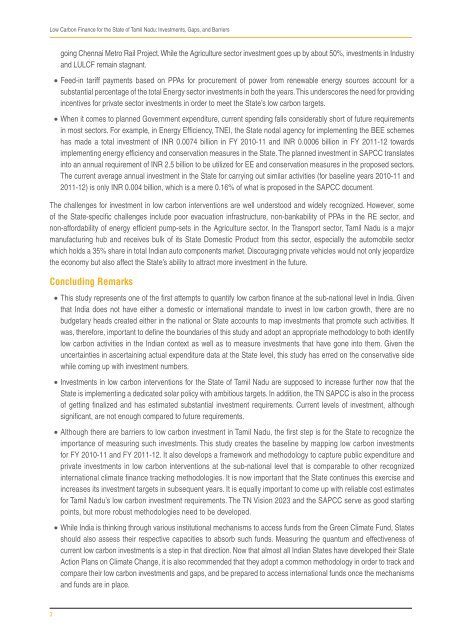Low-Carbon-Finance-for-the-State-of-Tamil-Nadu-Investments-Gaps-and-Barriers - Shakti Foundation
You also want an ePaper? Increase the reach of your titles
YUMPU automatically turns print PDFs into web optimized ePapers that Google loves.
<strong>Low</strong> <strong>Carbon</strong> <strong>Finance</strong> <strong>for</strong> <strong>the</strong> <strong>State</strong> <strong>of</strong> <strong>Tamil</strong> <strong>Nadu</strong>: <strong>Investments</strong>, <strong>Gaps</strong>, <strong>and</strong> <strong>Barriers</strong><br />
going Chennai Metro Rail Project. While <strong>the</strong> Agriculture sector investment goes up by about 50%, investments in Industry<br />
<strong>and</strong> LULCF remain stagnant.<br />
• Feed-in tariff payments based on PPAs <strong>for</strong> procurement <strong>of</strong> power from renewable energy sources account <strong>for</strong> a<br />
substantial percentage <strong>of</strong> <strong>the</strong> total Energy sector investments in both <strong>the</strong> years. This underscores <strong>the</strong> need <strong>for</strong> providing<br />
incentives <strong>for</strong> private sector investments in order to meet <strong>the</strong> <strong>State</strong>’s low carbon targets.<br />
• When it comes to planned Government expenditure, current spending falls considerably short <strong>of</strong> future requirements<br />
in most sectors. For example, in Energy Efficiency, TNEI, <strong>the</strong> <strong>State</strong> nodal agency <strong>for</strong> implementing <strong>the</strong> BEE schemes<br />
has made a total investment <strong>of</strong> INR 0.0074 billion in FY 2010-11 <strong>and</strong> INR 0.0006 billion in FY 2011-12 towards<br />
implementing energy efficiency <strong>and</strong> conservation measures in <strong>the</strong> <strong>State</strong>. The planned investment in SAPCC translates<br />
into an annual requirement <strong>of</strong> INR 2.5 billion to be utilized <strong>for</strong> EE <strong>and</strong> conservation measures in <strong>the</strong> proposed sectors.<br />
The current average annual investment in <strong>the</strong> <strong>State</strong> <strong>for</strong> carrying out similar activities (<strong>for</strong> baseline years 2010-11 <strong>and</strong><br />
2011-12) is only INR 0.004 billion, which is a mere 0.16% <strong>of</strong> what is proposed in <strong>the</strong> SAPCC document.<br />
The challenges <strong>for</strong> investment in low carbon interventions are well understood <strong>and</strong> widely recognized. However, some<br />
<strong>of</strong> <strong>the</strong> <strong>State</strong>-specific challenges include poor evacuation infrastructure, non-bankability <strong>of</strong> PPAs in <strong>the</strong> RE sector, <strong>and</strong><br />
non-af<strong>for</strong>dability <strong>of</strong> energy efficient pump-sets in <strong>the</strong> Agriculture sector. In <strong>the</strong> Transport sector, <strong>Tamil</strong> <strong>Nadu</strong> is a major<br />
manufacturing hub <strong>and</strong> receives bulk <strong>of</strong> its <strong>State</strong> Domestic Product from this sector, especially <strong>the</strong> automobile sector<br />
which holds a 35% share in total Indian auto components market. Discouraging private vehicles would not only jeopardize<br />
<strong>the</strong> economy but also affect <strong>the</strong> <strong>State</strong>’s ability to attract more investment in <strong>the</strong> future.<br />
Concluding Remarks<br />
• This study represents one <strong>of</strong> <strong>the</strong> first attempts to quantify low carbon finance at <strong>the</strong> sub-national level in India. Given<br />
that India does not have ei<strong>the</strong>r a domestic or international m<strong>and</strong>ate to invest in low carbon growth, <strong>the</strong>re are no<br />
budgetary heads created ei<strong>the</strong>r in <strong>the</strong> national or <strong>State</strong> accounts to map investments that promote such activities. It<br />
was, <strong>the</strong>re<strong>for</strong>e, important to define <strong>the</strong> boundaries <strong>of</strong> this study <strong>and</strong> adopt an appropriate methodology to both identify<br />
low carbon activities in <strong>the</strong> Indian context as well as to measure investments that have gone into <strong>the</strong>m. Given <strong>the</strong><br />
uncertainties in ascertaining actual expenditure data at <strong>the</strong> <strong>State</strong> level, this study has erred on <strong>the</strong> conservative side<br />
while coming up with investment numbers.<br />
• <strong>Investments</strong> in low carbon interventions <strong>for</strong> <strong>the</strong> <strong>State</strong> <strong>of</strong> <strong>Tamil</strong> <strong>Nadu</strong> are supposed to increase fur<strong>the</strong>r now that <strong>the</strong><br />
<strong>State</strong> is implementing a dedicated solar policy with ambitious targets. In addition, <strong>the</strong> TN SAPCC is also in <strong>the</strong> process<br />
<strong>of</strong> getting finalized <strong>and</strong> has estimated substantial investment requirements. Current levels <strong>of</strong> investment, although<br />
significant, are not enough compared to future requirements.<br />
• Although <strong>the</strong>re are barriers to low carbon investment in <strong>Tamil</strong> <strong>Nadu</strong>, <strong>the</strong> first step is <strong>for</strong> <strong>the</strong> <strong>State</strong> to recognize <strong>the</strong><br />
importance <strong>of</strong> measuring such investments. This study creates <strong>the</strong> baseline by mapping low carbon investments<br />
<strong>for</strong> FY 2010-11 <strong>and</strong> FY 2011-12. It also develops a framework <strong>and</strong> methodology to capture public expenditure <strong>and</strong><br />
private investments in low carbon interventions at <strong>the</strong> sub-national level that is comparable to o<strong>the</strong>r recognized<br />
international climate finance tracking methodologies. It is now important that <strong>the</strong> <strong>State</strong> continues this exercise <strong>and</strong><br />
increases its investment targets in subsequent years. It is equally important to come up with reliable cost estimates<br />
<strong>for</strong> <strong>Tamil</strong> <strong>Nadu</strong>’s low carbon investment requirements. The TN Vision 2023 <strong>and</strong> <strong>the</strong> SAPCC serve as good starting<br />
points, but more robust methodologies need to be developed.<br />
• While India is thinking through various institutional mechanisms to access funds from <strong>the</strong> Green Climate Fund, <strong>State</strong>s<br />
should also assess <strong>the</strong>ir respective capacities to absorb such funds. Measuring <strong>the</strong> quantum <strong>and</strong> effectiveness <strong>of</strong><br />
current low carbon investments is a step in that direction. Now that almost all Indian <strong>State</strong>s have developed <strong>the</strong>ir <strong>State</strong><br />
Action Plans on Climate Change, it is also recommended that <strong>the</strong>y adopt a common methodology in order to track <strong>and</strong><br />
compare <strong>the</strong>ir low carbon investments <strong>and</strong> gaps, <strong>and</strong> be prepared to access international funds once <strong>the</strong> mechanisms<br />
<strong>and</strong> funds are in place.<br />
3

















